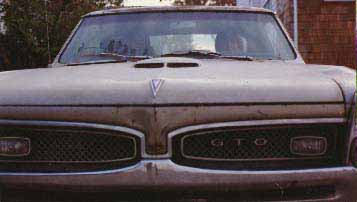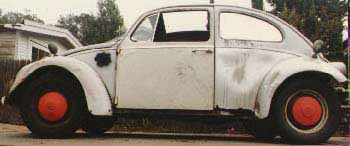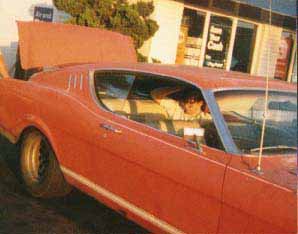Before the Impala, there was...

I got this extremely wretched 1967 Pontiac GTO for $113, about six months
after my 16th birthday. There was not an undented square foot to
be found anywhere on its body; it had the look of a car that had been used
in an experimental series of low-speed crash tests in which a '73 Buick
Electra had been pushed into it at about walking speed, repeatedly and
at every possible angle. All the weatherstripping had long since
turned into black powder, permitting water to pour freely into the car's
interior; in fact, mushrooms would grow on the carpeting behind
the front seats after a week or so of rain. The dashboard had been
cruelly chopped open with what was probably a chainsaw. It
had four different sized tires (including different diameters on the same
axle!) and a vinyl top that had been half-chiseled away. On the plus
side, it had a strong rubber-charring 400, 4:10 gears and a Hurst dual-gate
shifter, all of which I would not recommend for a 16-year-old, particularly
one whose entire driving experience up to that point had been obtained
behind the wheel of a '69 Toyota Corona. I got my first moving violation
(actually, it was two moving violations at the same time) on my
first drive around the block in the car, unwisely choosing to get sideways
at 80 mph (in a 25 zone, I'm proud to say) right in front of a traffic
cop. After a few wrecks and many sets of rear tires, I sold what
was left of the GTO a year later for $550 to an auto-body man who wanted
a real challenge.

After getting rid of the GTO, I decided it was time to get something a
little smaller and less likely to get my driver's license revoked before
I even got out of high school. A friend lived next door to a junkyard
in East Oakland and spotted this '58 VW with what he thought was a Porsche
engine sticking out the back. It ran and was $50, a price too good
to pass up. The car was completely gutted, with an all-bare-metal
interior, no gauges, and no vinyl top for the huge 3-foot-square sunroof.
The entire rear body had been torched off, leaving the engine protrucing
like a shelf, the bumpers were long gone, and the fenders had been chopped
down. It looked like a grim parody of the Baja Bugs then in vogue.
Nothing electrical worked other than the ignition (it was strictly a twist-wires-together
affair to start the thing). The engine turned out to be a 1600cc
Type III VW mill, the kind they put in those horrible late-60s "Squareback"
station wagons, but it had dual carbs and a dune-buggy-style straight-through
exhaust. The car sounded like the world's biggest chainsaw; it managed
to hit a perfect nerve-jangling note that caused the eardrums to flutter,
even a block away. Since it was stripped down to what was probably
a lot less than 1,000 pounds and had an engine much more powerful than
anything it was designed for, this Bug was fast. It was able
to beat any car in town... for about 1-1/2 blocks. The gearing in
the transaxle was designed for a 25-horsepower engine, so the Type III
was redlined and screaming at about 65 mph. Still, it was cool
to have a car that would lift the front tires if you dumped the clutch
hard (unfortunately, the instant the front tires lost their grip, the car
would swerve sickeningl to one side or the other, occasionally dumping
me out o the belt-less seat. I burned out the 6V wiper motors immediately
by using a 12V battery/generator, so I had to reach up through the always-open
sunroof with a squeegee to wipe the windshield during the rain. I
ended up selling the engine when I went off to college, leaving the car
at the family's house, and my parents, being sick of the thing, pushed
the car into the street so that it would get towed away.

My next car was this Competition Orange 1968 Mercury Cyclone. It
was actually reasonably intact, by my standards, though the heater, power
steering, and gas gauge didn't work. The original 302 engine had
been replaced with a 351 Windsor, and it had extra-redneck air shocks that
enabled me to jack the rear end up about three feet, giving me that "Aerosmith
Road Crew" look. The column shifter had been hacksawed off and a
Pinto floor shifter installed (with an ingenious garden-hose-and-clamp
linkage arrangement which gave me the choice of setting it up to get into
Park or 1st, but not both). The trunk was about ten feet deep, but
this photo clearly shows the tiny trunklid, which limited trunk access
to objects that would fit through the very restrictive opening. The
Cyclone was reasonably powerful and actually managed to get 20 MPG on the
highway. Note the cheapo gold universal-slotted rear wheels and fat
275 tires- this photo was taken in 1988; the same wheels and tires (painted
flat black) would end up on the Impala later on.







